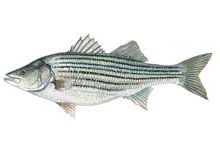Freshwater Fish - Species
Striped bass (Morone saxatilis) - Native
Description: (Anatomy of a Fish)
The coloration of the dorsum ranges from deep olive to steel blue and gradients to a silvery abdomen flanked by 7 to 8 longitudinal dark stripes (sometimes broken) running from behind the gills to the base of the tail. It is common for adult fish to exceed 10.8 inches and weight 20 pounds. The size helps distinguish this species from striped bass x white bass hybrid, which rarely exceeds 10 pounds.
Range:
All of South Carolina's coastal rivers support striped bass, the largest populations occurring in the Savannah, Cooper and Santee rivers. Excellent reservoir fisheries exist in lakes Marion, Moultrie, Murray and Wateree. Smaller populations are found in lakes Hartwell, Thurmond, Secession and Greenwood.
Average Length: 20 - 36 inches
Average Size: 3 - 10 pounds, About 60 pounds in freshwater or 120 pounds in saltwater
South Carolina State Record: 63 pounds (2009)
Life Expectancy: Approximately 30 years
Preferred Habitat
Striped bass are found in major rivers and large impoundments of South Carolina. They are also found in estuarine and coastal areas. They prefer cool waters and are diadromous throughout their range, except in South Carolina.
Diadromous fishes use both marine (saltwater) and freshwater habitats during their life cycle.
Food Habits
- The diet of striped bass consists mostly of fish.
- Preferred species in freshwater are threadfin shad, gizzard shad and blueback herring.
Spawning
- Prior to spawning in early spring, striped bass migrate up rivers. Spawning occurs when water temperatures reach 60-70°F. The semi-buoyant eggs are released in the flowing water and fertilized by several males in a thrashing event known as a "fight."
- As many as 3 million eggs may be released by one female. The eggs require a flow adequate to prevent their settling to the bottom during the incubation period of approximately 50 hours.
- During their first few days of life, the larval fish are sustained by a yolk material while they develop. Eventually they begin to feed on zooplankton.
Miscellaneous
Because striped bass need flowing water to spawn successfully, most reservoir populations are maintained solely by stocking. In South Carolina, only the Santee-Cooper reservoirs have suitable tributary rivers, the Congaree and Wateree, to meet their spawning needs. Other reservoirs have limited upstream river systems due to extensive dam construction. Unimpounded coastal rivers still provide adequate stream flow for hatching.
The "landlocked" reproducing population of the Santee-Cooper reservoirs was a unique phenomenon until recent discoveries of other reproducing populations in the Southeast and far West. South Carolina was a pioneer in developing striped bass hatchery techniques. As a direct result of work at the Dennis Wildlife Center in Moncks Corner, striped bass fisheries now exist in many reservoirs across the country.
Commonly Mistaken Species
Some species of fish that are commonly mistaken for this species:
Literature Cited
Rohde, Fred C, Arndt, Rudolf G., Foltz, Jeffery W., Quattro, Joseph M. 2009. Freshwater Fishes of South Carolina. University of South Carolina Press, Columbia, South Carolina.
Wildlife and Freshwater Fisheries Division. 2009. South Carolina Guide to Freshwater Fishes.
Fish Illustration by Duane Raver.

